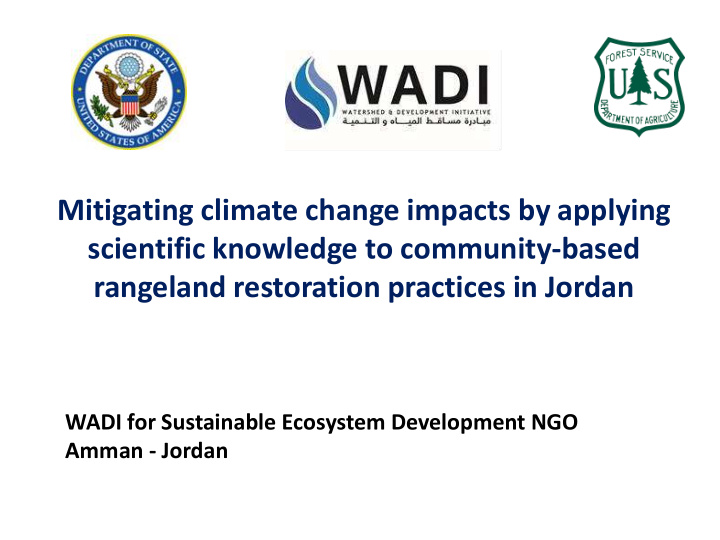



Mitigating climate change impacts by applying scientific knowledge to community-based rangeland restoration practices in Jordan WADI for Sustainable Ecosystem Development NGO Amman - Jordan
WHO WE ARE? WADI’s vision: healthy watersheds managed by resilient communities. 2
Introduction: • Located in the Middle East, Western Asia • Area: 89,342 km 2 • Population: 10 millions • Language: Arabic
Annual per capita water availability 1946 2010 2025 3600 m3/year 145 m3/year 90 m3/year
Studies on Climate Change and Water Scarcity In a study on the impact of global warming on groundwater resources of Jordan. Increase Groundwater recharge reduction Average rainfall is 2 C o 21% 4 C o 37% expected to decrease 6 C o 50% by 20% by 2050 Rainfall Decrease Groundwater recharge reduction 10% 25% 20% 48% 30% 61%
Jordan Nationally Determined Contributions (NDC’s) • By 2030, -14% reduction of GHG emissions. • Unconditional part of mitigation target 1.5% (0.542 B $) • Conditional part of mitigation target 12.5% (5.517 B $) Priority Mitigation Measures • Renewable energy • Transportation • Green growth policies • Reforestation… etc Afforestation of 25% of barren forest areas on which the rate of precipitation exceeds 300mm.
Jordan’s Ecosystems: Forests constitute around 1%. Rangelands constitute around 80% of Jordanian territories.
Rangelands in Jordan: Historically, rangeland were lush with vegetation that sequestered CO 2 , controlled soil erosion, nourished livestock, and stored rainfall to replenish other water sources. 8
Rangelands in Jordan: Today, due to years of over exploitation, harsh environmental conditions and regional conflicts, much of the Badia rangeland is barren. 9
Rangeland Ecosystems restoration in Jordan: Efforts for ecosystem restoration usually disregard proper community involvement, have poor seedling quality, and problems with the planting process. 10
The target plant concept Southern pine Phases of the target plant concept • Morphological Landis, 2011. Modified from Wakeley, 1954. (stem diameter, shoot height, root volume..etc) • Physiological (nutrient content, soluble carbohydrates… etc) • Link seedlings performance at planting site to nursery practices and identify desirable attributes) Seedling Quality is assessed according to its performance at restoration sites.
The target plant concept Dumroese et al, 2016
Methodology Community nurseries as novel approach in ecosystem rehabilitation and community engagement Selection criteria: • Biophysical criteria; land and water sources. • Socio-economic criteria; engaged and motivated staff.
Value Chain Approach 14
Behavioral Change Monitoring and Supplies Evaluation • Containers • Documentation • Media mix • Evaluating seedlings components performance • Irrigation management • Devices Procedures • Homogenous media mixing • Block weight method • Applicable protocols • Capacity building
Capacity building programs
Growing Media and Stocktype Selection Hydrogel Peatmoss Cocopeat 1.5% v/v 50% v/v 50% v/v Controlled Perlite Release fertilizer 10% v/v 3.5 g/L 17
Growing Media and Stocktype Selection 18
Uniform Media Mixing 19
Irrigation Management Efficient unified irrigation and measurable quantities of irrigation water. 20
Monitoring and Evaluation 21
Results Uniform seedlings Save up to 70% of water required for seedlings production 22
Restoration 23
Restoration 20% 70% 24
Conclusions Restoration
Afforestation of 25% of barren forest areas on which the rate of precipitation exceeds 300mm. Rangelands 100X Forest 26
Trees Shrubs Size 1.5 m Short Long Time 27
Main restoration benefits • Climate change mitigation and adaptation • Build marginal communities' resilience and livelihoods • Rainfall filtration and storage • Biodiversity conservation and habitat restoration • Arrest land degradation and combat desertification • Food and medicinal herbs • Fodder • Eco-tourism ………………………and many other benefits
Partners: 8/28/2017 29
Thank you for listening Photo taken at Hazeem oasis, 30 Jordan Eastern Badia
Recommend
More recommend